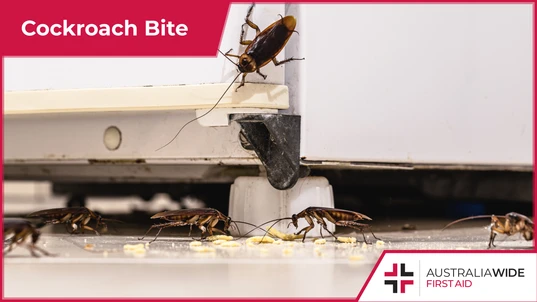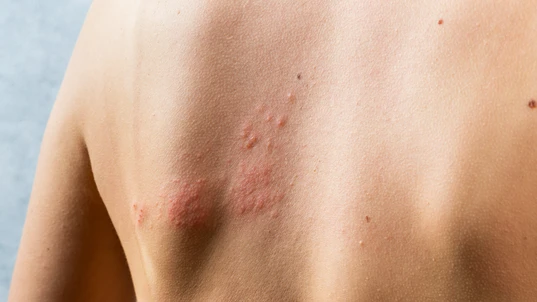First Aid for Cockroach Bites

Bites and Stings

Cockroaches are omnivores that eat anything. In fact, they have been known to bite people to feed off dead skin and food residue on their face and hands. Cockroaches are not venomous, but they can transmit deadly bacteria like E.coli.
Cockroaches are agile creatures that eat everything. While they are pesky omnivores that usual stick to enjoying leftover food scraps around your home, be ready to hate them a little bit more. Cockroaches can bite you in extreme circumstances - feeding off body parts that commonly have dead skin or food residue. With incredible evolutionary hereditary, cockroaches can be traced back to the time of the dinosaurs and over millions of years, cockroaches have developed the ability to fly or glide, move quickly and hide in crevices, and even survive up to a week without a head. Cockroaches are everywhere and despite their peskiness, they play an important role in Australia’s ecosystem. While cockroaches carry harmful bacteria, a cockroach bite is unlikely to cause severe illness, but can result in infection or allergic reactions. Read on to learn about the common cockroaches found in Australia, why they might bite you, and how to treat them. To learn first aid for insect bites, sign up to one of our general first aid courses, or a specialised one for educators or support staff. We have locations all around Australia.Common types of cockroaches in Australia
Cockroaches are incredible creatures and have found a way to survive on every continent in the world (even Antarctica!). They have even been experimented on in space! Without their long antennae, which allows them to feel and smell the world around them, cockroaches grow between 12 - 50mm long. They are black or brown in colour and their heads point downwards as if sniffing the ground. A cockroach can live with its head as its nervous system and internal breathing mechanism is housed within its body. A headless cockroach will survive for about a week before eventually dying of thirst. Strangely enough, when cockroaches have been affected by insecticide, they are known to come out of their hiding and die in an open floor upside down. All cockroaches have wings, but different species have different abilities - don’t be surprised if you see one fly unexpected distances. Cockroaches transmit harmful bacteria like salmonella and E.coli, but are not venomous. It is important to keep things clean to avoid an infestation. Of the 4000+ species, Australia has 450 types of native cockroaches. The Australian Cockroach, the German Cockroach and the American Cockroach are three species you have likely spotted around your home before. These cockroaches can be found in damp and moist climates, and they like to have easy access to water, such as the drains in bathrooms and kitchens.The Australian Cockroach
Brown with a yellow band around its head, the Australian Cockroach hides during the day in cracks and crevices and scavenges for food at night. The Australian Cockroach can grow up to 35mm long.The German Cockroach
Light brown with clear dark lines along the edge of its body, the German Cockroach is small (grows up to 16mm), quick and likes to hang out in the dark and humid corners of kitchens and bathrooms. The German Cockroach is often seen scuttling away after food pantry doors expose them.The American Cockroach
Reddish brown with a light yellow band behind the head, American Cockroaches and Australian Cockroaches are often confused. American Cockroaches are active, can glide with their wings and their droppings give off a musty odour. With the ability to survive in dry areas, American Cockroaches still tend to prefer warm, dark, and humid spaces.Looking to get you First Aid knowledge up to date?
We run certified First Aid courses throughout all major Acustralian citys. Find a location near you.
Why do cockroaches bite people?
Cockroaches will bite in extremely rare situations, such as when an ongoing home infestation is unable to find food for themselves. In this case, they might scavenge your skin for food residue, and usually bite around the fingernails, eyelashes, and mouth. They have been known to eat human flesh - both dead and alive. Cockroaches are nocturnal and will bite at night. For this reason, cockroach bites are often misidentified for bed bug bites. If you believe you have a cockroach infestation, it is advised to contact a pest control expert, such as Allstate Pest Control, as soon as possible.What are the symptoms of a cockroach bite?
You will not die from a cockroach bite. However, you might develop a bright red itchy lump that can cause swelling, irritation, and lesions.Are cockroach bites dangerous?
While cockroaches do carry around nasty parasites and bacteria that can cause serious illness, they are not venomous. Apart from monitoring for an allergic reaction, cockroach bites should be treated like any other insect bite.
Cockroaches are not venomous. However, their bites can cause symptoms of an allergic reaction, like the rash pictured above. If a person begins exhibiting signs of a severe allergic reaction (anaphylaxis), you should call for an ambulance immediately.
First aid for cockroach bites
Cockroach bite first aid consists of the following steps:- Remove the person from the area where they were bitten as soon as possible
- Wash the bite site with soap and water, and apply an antiseptic
- Apply a cold compress or calamine lotion to the bite site to help reduce local pain and swelling
- You can also take an antihistamine to relieve the swelling and itching. These medicines should be readily stocked in your DIY first aid kit
- Resist the urge to scratch the bite site, as this may cause an infection
- If the person begins showing signs of a severe allergic reaction, call Triple Zero (000) for an ambulance, consult the Australian Resuscitation Council's anaphylaxis treatment guideline, and follow DRSABCD and be prepared to perform CPR
- Cockroach bites usually go away on their own, but see a doctor if the bite does not improve or if you develop any other symptoms
Final thoughts
Cockroaches are one of the most common insects around Australia, and in extremely rare circumstances they are known to bite humans. Cockroaches transmit harmful bacteria like salmonella and E.coli, but are not venomous. If bitten by a cockroach, be sure to monitor for allergic reaction or subsequent infection and apply first aid. If you are interested in knowing more about first aid for insect bites, sign up to one of our general first aid courses, or a specialised one for educators or support staff. We have locations throughout Australia.
Originally published at
https://www.australiawidefirstaid.com.au/resources/cockroach-bite
as part of the Australia Wide First Aid Articles Library









